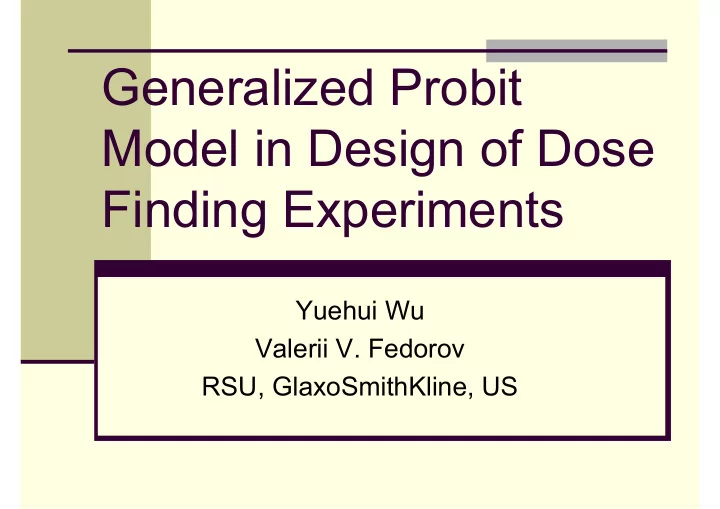

Generalized Probit Model in Design of Dose Finding Experiments Yuehui Wu Valerii V. Fedorov RSU, GlaxoSmithKline, US
Outline � Motivation � Generalized probit model � Utility function � Locally optimal designs � Simulation
Motivation � In dose-finding studies, one popular goal is to locate the best dose � What does “best” mean? � Balance between efficacy and toxicity � Need to model for multiple endpoints � Observe continuous responses � Report results based on dichotomized responses
Background Model � Continuous responses (may not be observed) � Some function of Z is reported (used), e.g. dichotomization
Bivariate Probit Model � Both responses are dichotomized: Y 1 for toxicity, Y 2 for efficacy � Note: if c k is unknown, in general, σ k is not estimable. Here we assume σ k =1 and known.
2D dichotomization
Utility Function � Goal: locate an efficacious while non-toxic dose � A regulatory agency is interested only in function no matter the observed responses are continuous or not � Toxicity responses are binary and efficacy responses are continuous
Dose-Response Curves and Utility Function dose
Dichotomize or not? � Utility function is based on dichotomized responses � When the continuous observations are available, do not use dichotomized responses in the analysis because dichotomization leads to loss of information � If one needs to report the results based on dichotomized responses, use utility function
Locally Optimal Design � Most popular goal: locate the dose which achieve the maximum value of utility function � Locally optimal design � Design criterion: � L( Θ )- optimality: � D-optimality:
Numerical Algorithm � Sensitivity function � L( Θ )-optimal � D-optimal � First order exchange algorithm � Forward step � Backward step
Design with Cost Constrains (no example) � It’s unethical to assign patients to non-efficacious or potentially toxic doses � May introduce penalty function � Corresponding design criterion � Corresponding sensitivity function
Information Matrix � Notation Design: Information matrix: � Both responses are continuous
Information Matrix (2) � Both responses are binary, ρ is known � When ρ is unknown, see GSK Technical Report 2006-01
Example � Design region: [0,1] � Parameter values: (1 . 5 ; 2 . 7 ; 0 . 05 ; 2 . 2) � For the same utility function with cut off value c1=0.5, c2=0.1 � Assume ρ =0.5 and known � Locally optimal designs: � Using continuous responses � Using binary responses
Locally optimal designs L( Θ )-optimal D-optimal dose
Impact of dichotomization � Assume continuous responses are available, binary utility function is used � Sample size n=200 � Will using dichotomized responses in the analysis have negative impact on the precision of parameter estimations?
Precision comparison (1) � Number of subjects needed to get the same precision of
Precision comparison (2) � Number of subjects needed to get the same precision of
Simulation � Generate 200 continuous observations according to four designs: L and D optimal designs under bivariate probit model and bivariate linear regression model respectively � Fit bivariate linear regression model to obtain parameter estimation, calculate corresponding utility function and locate the target doses � Dichotomize the same continuous observations and fit bivariate probit model with cutoff values c 1 = 0.5 and c 2 = 0.1 and estimate the target dose � Repeat the procedure 1000 times to compare the distributions of the estimated target doses under the two models.
L( Θ )-optimal design results Target dose under true parameters
L( Θ )-optimal design results (2)
D-optimal design results
D-optimal design results (2)
Conclusion � Use continuous responses in the analysis whenever they are available � The utility function can be based on either continuous or dichotomized response by whatever is expatiate � L( Θ )- optimal design is more complicated to derive � D-optimal is a robust choice for different study goals
References � Fedorov, V.V. Theory of Optimal Experiments , 1972, New York: Academic Press. � Fedorov, V.V. and Hackl, P. Model-Oriented Design of Experiments ; Lecture Notes in Statistics 125; Springer-Verlag, New York, 1997. � Dragalin, V., Fedorov, V., and Wu, Y. (2006). Optimal Designs for Bivariate Probit Model. GSK Technical Report 2005-07 . 62 pages. http://www.biometrics.com/downloads/TR_2006_01.p df. � Fedorov, V. and Wu, Y. Dose Finding for Binary Utility. Submitted to Journal of Biopharmaceutical Statistics.
Recommend
More recommend